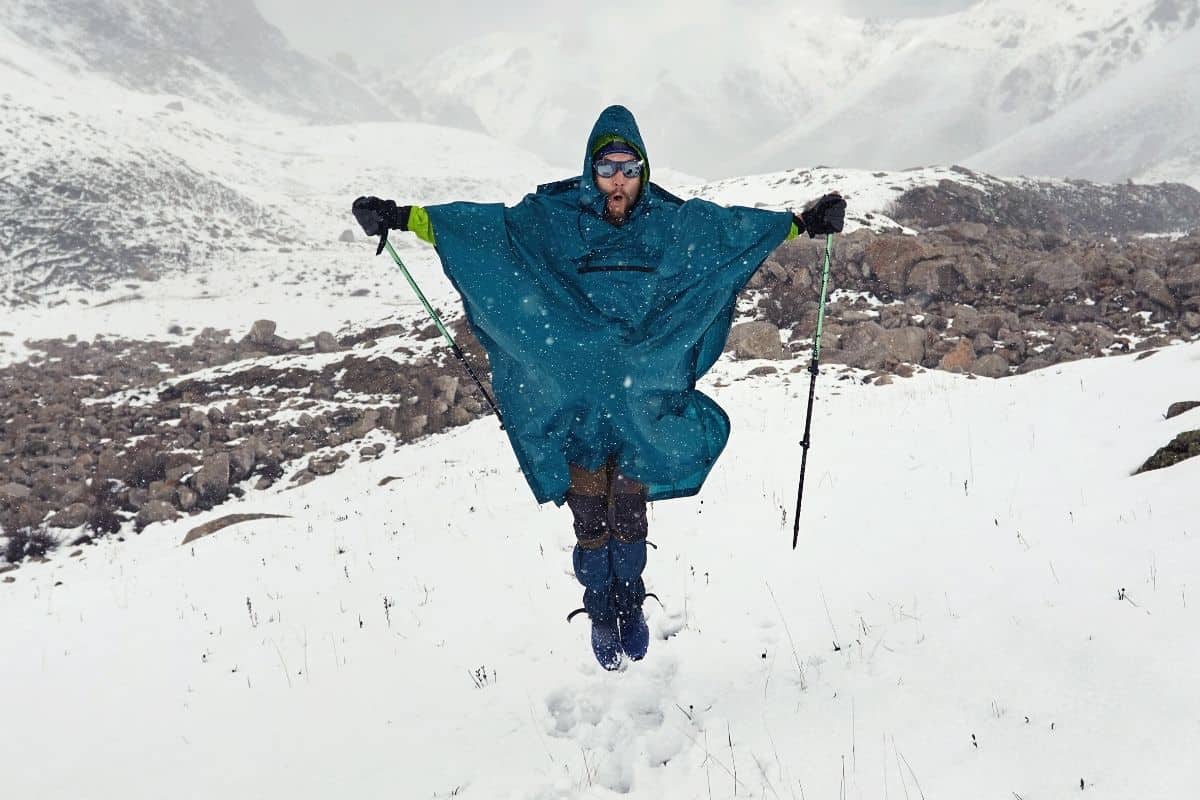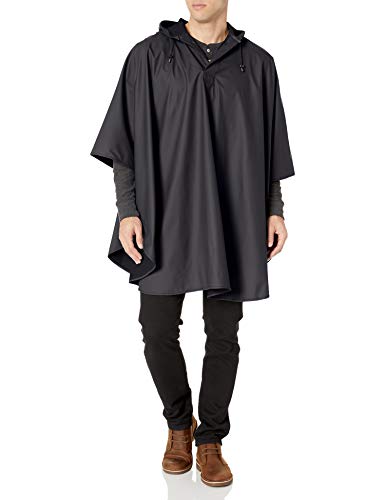Mother nature is fickle and unpredictable. One minute we’re hiking in glorious sunshine, the next we’re getting drenched in the kinda deluge that has folks building arks.
Ark-building aside, what can we do to protect ourselves when the weather takes a turn for the biblical while we’re out on the trails?
Well, carrying waterproofs is never a bad start. But what about those days when even these won’t keep us dry? Or those sunny days when carrying 3 pounds of water-resistant pants and jackets seems like overkill?
Enter the waterproof poncho!
This lightweight, low-volume piece of kit has a lot to offer. Good waterproof ponchos allow you to double down on waterproofing with an all-but impermeable external layer whilst weighing next to nothing. They can be left at the bottom of your backpack and forgotten about until needed. Heck, in a pinch they can moonlight as an emergency tarp shelter!
Not bad for an accessory deemed optional or unnecessary by many, right?
Making your own DIY poncho is easy to do. But for those of you with less time on your hands, we’ve drawn up a list of the top hiking-specific ponchos on the market and included a comprehensive guide that will help you find the best one for your backpacking and hiking adventures.
Table of Contents
Our Top Picks by Category:
Budget Buys: Terra Hiker and F TOGGS Ultra-Lite
Multifunctional: Terra Hiker, S2S Ultra-Sil Nano, Mil-Tec, and Deerhunter Survivor
Under 10 oz.: S2S Ultra-Sil Nano, Terra Hiker, F TOGGS Ultra-Lite, and Exped Pack UL
Most Durable: S2S Ultra-Sil Nano, Snugpak Patrol, CRA Pacific, Mil-Tec, and Deerhunter Survivor
Editor’s Choice
Sea to Summit Ultra-Sil Nano Tarp Poncho
The S2S Nano is far from your average poncho. It’s tough, lightweight, waterproof, offers full-body coverage, and, unlike most of its peers, can be converted into a tarp, groundsheet, backpack rain cover, or an emergency two-person shelter in seconds.
This poncho is made with rugged, waterproof, 15-denier fabric and uses double-stitched, waterproof taped seams for added durability and leak prevention. Measuring 57” x 104”, it’s also roomy enough to accommodate a large backpack and long enough to cover taller hikers down to the knee or ankle.
There’s no getting around the fact that this is a pricey product. However, given the quality of its design and impressive multifunctionality, it’s a great pick for anyone keen to get their hands on the best rain poncho for hiking their money can buy.
Bottom Line: A next-level kinda poncho that’s tougher, more versatile, and more trail-ready than the best of the rest.
At a Glance: Quick Recommendations
-
Editor’s Choice:
Sea to Summit Ultra-Sil Nano Tarp Poncho
“Lightweight, durable, fully waterproof, and versatile to boot, this intelligently designed poncho is a standout performer in every important metric.” -
Best for Hiking:
Snugpak Patrol Poncho
“A well-made, hiking-specific poncho that’s extra-tough and boasts a few super-handy bonus features.” -
Best Heavy-Duty:
Charles River Apparel Pacific Rain Poncho
“A burly, hard-wearing model that’s a little short on features but built to last a lifetime.” -
Best Budget:
Terra Hiker Rain Poncho
“A fairly priced option that boasts a better feature set than many of its pricier competitors.” -
Best Value:
FROGG TOGGS Ultra-Lite
“A lightweight, thigh-length, waterproof-breathable poncho that doubles as a tarp shelter or groundsheet.” -
Best Multi-Purpose:
Mil-Tec Waterproof Rain Poncho
“This one’s extra-tough, ripstop materials and multifunctionality make it a great option for backpackers.” -
Most Sustainable:
VAUDE Hiking Backpack Poncho
“An outstandingly well-made, waterproof-breathable model with adjustable length and impressive eco-credentials.” -
Best Waterproof:
Deerhunter Survivor Rain Poncho
“With a hydrostatic head of 3,000 mm and a waterproof-breathable membrane, this is among the most waterproof yet breathable rain ponchos for hiking out there.” -
Best Ultralight:
Exped Pack UL Rain Poncho
“The Exped’s tiny packed size and negligible weight make it a great pick for backpackers and gram-counting hikers.”
The Best Rain Poncho for Backpacking & Hiking: Our Top 9 Picks
Sea to Summit UltraSil Nano Tarp Rain Poncho
Weight: 8.1 oz. ⸱ Material: 15D Ultra-Sil Nano fabric with taped seams ⸱ HH rating: 1,200 mm
If you’ve already been converted to poncho-wearing and want a model that makes the average poncho look like an elaborate trash bag, look no further than the S2S Ultra-Sil Nano.
The Nano ticks all the must-tick boxes and throws in a few far-from-standard, next-level features that make it one of the coolest, most practical, and most intelligent pieces of outdoor gear we’ve ever come across.
Made with 15D Ultra-Sil fabric, the Nano is one of the most durable water-repellent rain ponchos in our review. And despite measuring a mighty 57” x 104”, it weighs just 8.1 oz., making it the second lightest option on our list after the Exped Pack UL.
It also has a fully adjustable peaked hood, handy side snaps that let you increase airflow when necessary, and a drawcord hem that lets you tighten the waist to avoid billowing and flapping.
What makes the Nano stand out, however, is its versatility. When you’re not wearing it, it can be deployed as a backpack cover, groundsheet, or two-person tent thanks to the intelligent configuration of materials and the inclusion of grommets that can be used to stake it out with guylines or trekking poles.
PROs
- Lightweight
- Tough
- Waterproof fabric
- Sealed seams
- Multifunctional
CONs
- Pricey!
Bottom-Line: An expensive but high-quality poncho that takes practicality and versatility to a whole new level.
Snugpak Patrol Poncho
Best for HikingWeight: 13 oz. ⸱ Material: 100% nylon with fully taped seams ⸱ HH Rating: NA
Ponchos have long been considered a less practical option for hiking than a standard rain jacket. In the Snugpak Patrol, however, we find a model with several features that help to bridge the gap between the two.
Tipping the scales at 13 oz., this is among one of the heavier options on our list. But in return for the added weight, you get an oversized fit, extra-durable material, and a few hiker-friendly add-ons that are worth an extra ounce or two on your back.
The features that make this one our top pick for hiking are the thumb loops, half-length front zipper, and oversized chest pocket. While the loops help to keep your hands warm and reduce drafts sneaking up your sleeve, the front zipper provides a welcome ventilation point, and the chest pocket is a handy place to store small essentials like a map, phone, or compass.
PROs
- Waterproof fabrics
- Chest map pocket with storm flap
- Thumb loops
- Drawstring hood
- Compressible drawstring sack included
CONs
- Quite heavy
Bottom-Line: A well-designed model that boasts a few non-standard features that make it more suitable and convenient for use on the trail.
Charles River Apparel Pacific Rain Poncho
Best Heavy-Duty PonchoWeight: 17.1 oz. ⸱ Material: 100% polyurethane bonded to a 100% polyester knit with heat-sealed seams ⸱ HH Rating: NA
Looking for a burly, no-nonsense kinda poncho that’s built to last a lifetime? If so, then the CRA Pacific is well worth a look.
Weighing 17.1 oz., the Pacific is the heaviest model on our list. Its lack of pockets, thumb loops, and less breathable material also means it isn’t the most trail-specific option. Nevertheless, it does a lot to atone for these shortcomings.
Made with a 0.33mm polyester knit with a hydrophilic polyurethane coating, the Pacific is the burliest model in our review and among the most durable. It’s also fully waterproof, has heat-sealed seams to prevent leaks, and uses side-snap closures allowing you to choose between sleeved and sleeveless configurations.
Measuring 50” x 80”, this is one of the shorter models on our list but also one of the roomiest, so you will have plenty of room for a larger backpack but may need to wear a pair of waterproof pants underneath.
PROs
- Waterproof
- Highly durable fabric
- Sealed seams
- Available in multiple colors
- Side-snap closures under arms
CONs
- Heavy
- Bulky packed size
Bottom-Line: This PU-coated, heavy-duty rain poncho might be the heaviest on our list, but its burly fabric also makes it one of the toughest.
Terra Hiker Rain Poncho
Best BudgetWeight: 9.3 oz. ⸱ Material: 210T, high-density, PU-coated polyester fabric, and seam-sealed ⸱ HH rating: 3,000mm
This low-cost option may lack the prestige of big-name branding, but it offers similar performance to many far pricier competitors.
The Terra Hiker is made with robust 210T, high-density, PU-coated polyester fabric. And with a 3,000 mm hydrostatic head rating it rivals other higher priced models in the waterproof stakes.
For such a fairly priced product, this one has a lot of lovable design features, most notably its wired peak, adjustable hood, velcro cuffs, and reinforced eyelets that can be used to turn it into a tarp shelter or sunshade.
PROs
- Affordable
- Can accommodate a 60L backpack
- Dries quickly
- Multifunctional (doubles as tarp shelter)
- Velcro cuffs
CONs
- Slightly heavy
Bottom-Line: An affordable and versatile option that’s big enough to cover even a huge backpack.
FROGG TOGGS Ultra-Lite
Best ValueWeight: 9 oz. ⸱ Material: Polypropylene with welded waterproof seams ⸱ HH Rating: NA
If keeping weight to a minimum is more of a priority than full-body coverage, this FROGG TOGGS poncho is worth a place on your shortlist.
Weighing just 9 oz., this is the third lightest option on our list after the Exped Pack UL and S2S Nano. Compared to both of these models, the FT UL is significantly shorter and narrower, and a lot less durable due to its polypropylene construction. It’s also, however, a darned sight cheaper, so is still an excellent option for the occasional user.
Compared to more expensive rain ponchos, the FT UL is a little short on features. There’s no pocket, wired peak, zipper, or velcro cuffs. It does, however, have an adjustable hood and side-snap closures.
PROs
- Lightweight
- Available in 4 colors
- Waterproof-breathable fabric
- Welded seams
CONs
- Short and narrow (36” x 44”) – less room for a backpack underneath
- Not the most durable option
Bottom-Line: An affordable, lightweight option that’s made with waterproof-breathable fabric and comes with a reassuring one-year warranty.
Mil-Tec Waterproof Poncho
Best Multi-PurposeWeight: 11.46 oz. ⸱ Material: 100% Polyamide, PVC coated Ripstop with welded seams ⸱ HH Rating: NA
The Mil-Tec is another dual-purpose model that’s well worth considering for peeps who like rain gear that can multitask.
In addition to being an extra-tough, fully waterproof, and well-designed rain-blocker during the daytime, at night it can easily be converted into a groundsheet or tarp shelter thanks to its use of eyelets on the hem and stud poppers on the sides.
Compared to the other multitaskers in our review, the S2S Ultra-Sil Nano, Terra Hiker, and Deerhunter Survivor, the Mil-Tec is a good middle-of-the-road option. Its ripstop material makes it a far more durable choice than the Terra Hiker, and it’s also lighter than the Deerhunter Survivor and a lot cheaper than the S2S Ultra-Sil.
PROs
- Ripstop fabric
- Waterproof
- Measures 56.6” x 87.7”
- Multifunctional
CONs
- Quite heavy
- Large packed size
Bottom-Line: A tough, well-made option that converts easily into a groundsheet or sleeping bag cover.
VAUDE Hiking Backpack Rain Poncho
Most SustainableWeight: 15.5 oz. ⸱ Material: 100% Polyamide ⸱ HH Rating: NA
Made with waterproof, breathable, and windproof fabric, the Vaude is among the most performance-oriented options on our list. This makes it a great choice for hikers keen to leave their waterproof jacket and pants at home. And because it’s made with sustainable, eco-friendly, bluesign-approved materials, it’s also one of the most ethical options available.
Weighing in at 15.52 oz., this is the second heaviest model in our review, after the CRA Pacific. Unless you plan on using it for multi-day backpacking trips, however, don’t let this put you off, because the Vaude has a lot to offer that makes those extra few ounces well worth tolerating.
For starters, this is one of the few models on our list with a chest pocket – a small feature, maybe, but one you always notice when it isn’t there. Secondly, its length can be adjusted to reduce flapping and prevent you from tripping on the fabric. Thirdly, its polyamide fabric is as burly as they come and capable of keeping you dry even in heavy rain.
PROs
- Eco-friendly
- Adjustable length
- Waterproof, windproof, and breathable
- Chest pocket
- Taped seams
CONs
- Heavy
- Pricey
Bottom-Line: This sustainably produced option has an adjustable length that can be adjusted to suit the user and prevents it from blowing in the wind.
Deerhunter Survivor Rain Poncho
Best Waterproof PonchoWeight: 13.44 oz. ⸱ Material: 100% Polyester with taped seams ⸱ HH rating: 3,000mm
For hikers who want a little extra protection than your average waterproof poncho can provide, the Deerhunter Survivor is our top pick.
With a hydrostatic head of 3,000 mm, fully sealed seams, and an impressive breathability rating, this is both waterproof and the most likely to prevent you from perspiring excessively when hiking hard.
Weighing 13.44 oz., and with a packed size of 13” x 11”, this is one of the heavier and bulkier options on our list. Some of that added weight, however, goes into the addition of a large zippered chest pocket and rear grommets that let you convert it into a tarp or hunting hide – features that will be well worth having for some.
PROs
- Completely waterproof
- Breathable
- Large, zippered chest pocket
- Converts into a tarp
CONs
- Relatively heavy
- Large packed size
Bottom-Line: This is the only model listed that uses a waterproof-breathable membrane, making it a great pick for high-intensity hiking in everything from light rain to torrential downpours.
Exped Pack UL Rain Poncho
Best Ultralight PonchoWeight: Small: 7.1 oz., Medium: 7.6 oz., Large: 8.3 oz. ⸱ Material: 15 D ripstop nylon, silicone/PU coated and seam taped ⸱ HH rating: 1,500mm
Like all backpacking ponchos, the Exped Pack UL makes a few compromises due to its light weight. Nevertheless, it’s a great pick for anyone who wants a dialed-in design, hiking-specific features, and extra-tough materials without paying a weight penalty.
At 7.1 oz., this is the lightest model on our list. Its 15d ripstop nylon fabric, however, also makes it among the toughest.
Unlike other ultralight options, this Exped backpacking rain poncho doesn’t skimp on features. There’s an integrated compartment for large backpacks, a “smartpack” attachment loop, an anatomically shaped hood with a wired brim, a large internal pocket that doubles as a packsack, and snap-button sleeves.
And the compromises? Well, the Exped’s 1,500 mm hydrostatic head rating means it’s far from the most waterproof model on our list. While capable of keeping you dry in moderate rain showers, we’d rather have the Deerhunter Survivor, Snugpak Patrol, or S2S Nano on our backs in a torrential downpour.
PROs
- Ultralight
- Internal pocket
- Fully taped seams
- Available in 3 sizes
- Ripstop fabric
CONs
- Pricey
- Low waterproof rating
Bottom-Line: If you’re looking for the best backpacking poncho, this one’s tiny packed size and weight make it a shoo-in contender!
Why Take a Waterproof Poncho on The Trails?
Once eschewed by “serious” hikers as an unnecessary and impractical fad, in recent years rain ponchos have gained serious traction in the outdoors world. Below, we’ve listed the reasons for this rise in popularity.
- They’re more affordable than rain pants and rain jackets
- They’re lightweight
- They’re compact
- They keep you and your backpack dry
- Many models double as a tarp or emergency shelter
- They provide better ventilation than jackets
- Some provide full-body coverage
In the interests of a balanced argument, here are some reasons why you might prefer to plump for an old-fashioned pants-and-rain-jacket combo instead:
- They don’t offer the same level of wet-weather protection as hardshell jackets and pants
- They tend to billow and flap in windy conditions
- You kinda look like the grim reaper when wearing one

What to Look for in a Lightweight Rain Poncho for Hiking
Water Resistance
Different poncho models offer different levels of water resistance. While some are designed to keep you dry no matter how hard the rain’s falling, others are only capable of withstanding light and short-lived rain showers.
The factor that determines a poncho’s level of waterproofness more than any other is the material used in its construction.
Materials
The most commonly used materials are nylon, polyester, and polypropylene.
- Nylon – Although nylon isn’t a very water-resistant material in itself, most nylon-based rain ponchos use nylon that’s PU, PVC, or silicone-impregnated to provide added water repellency. Nylon is less breathable than polyester, but it’s also more durable and resistant to punctures and abrasion.
The Snugpak Patrol and Exped UL are the only nylon models in our review.
- PU-Coated Polyester – In this case, polyester is treated with a liquid protective film made of waterproof polyurethane that also makes the fabric tear-resistant.
The Charles River Pacific and Terra Hiker are made with PU-coated polyester.
- Polypropylene (PP) – While famous for its versatility, PP is not the most durable option and is typically only used in budget-priced ponchos.
The F TOGGS Ultra-Lite is the only polypropylene model in our review.
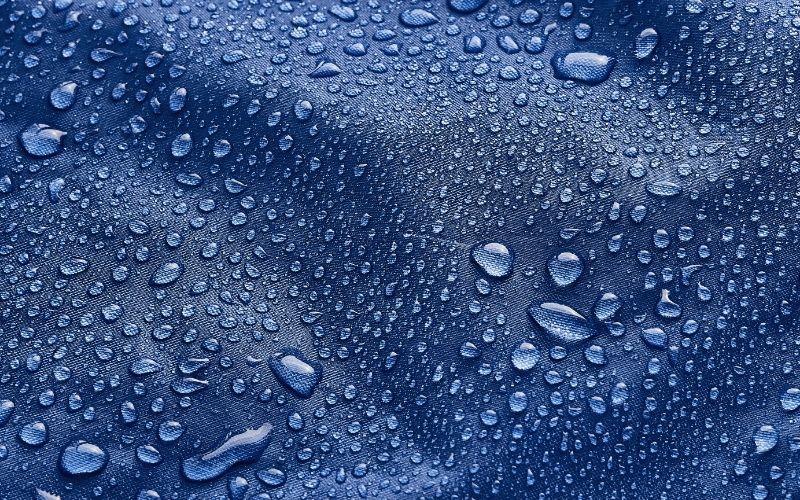
Waterproof Rating
Most manufacturers will list their products as either “water-resistant” or “waterproof”, but the only way to know the level of weather protection they provide for sure (short of treating them to the acid test of a wet day on the trails) is to look for the fabric’s hydrostatic head rating.
Hydrostatic head ratings are used to measure how much water pressure a fabric can withstand before it begins to leak, the higher the HH rating, the more waterproof the fabric will be. In product descriptions, this rating is given in millimeters (i.e. 3,000 mm).
In our review, the ponchos with the highest HH are the Deerhunter Survivor and the Terra Hiker.
Breathability and Ventilation
Rain ponchos’ loose fit means that they are far better ventilated than standard rain jackets. The main benefit of this is that they allow your sweat and body heat to escape while you hike, thereby reducing the risk of overheating or your interior layers becoming saturated in perspiration.
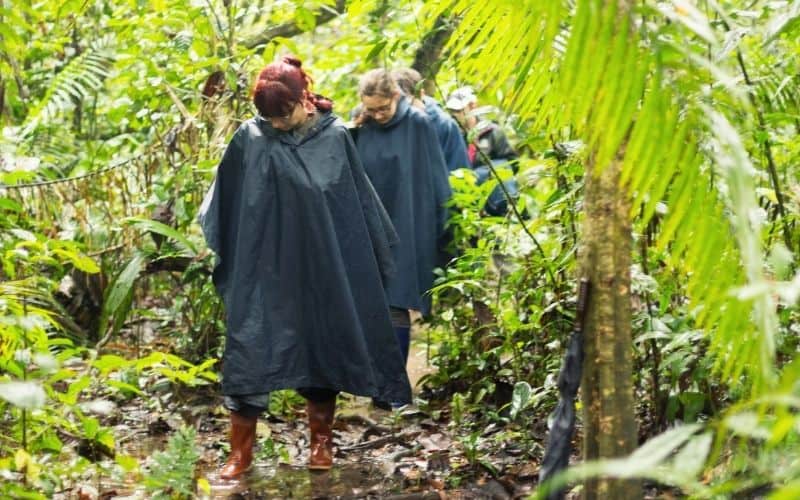
Nevertheless, many of the coatings used to produce rain ponchos with added water repellency use fabric that is far less breathable than the types used in waterproof-breathable rain shells. As such, a few extra ventilation features are needed to avoid things getting stuffy.
Some have pit zips that allow you to boost airflow to the upper body without exposing yourself to the rain, while others have side poppers or a full-length main zipper that can be opened/downed to dump heat when necessary. Models that use a waterproof-breathable membrane, like the Deerhunter Survivor, are generally the most breathable of the bunch.
Fit and Mobility
Most ponchos are “one-size-fits-all,” but this doesn’t mean that all ponchos are the same size – far from it.
When buying, you need to think not only about your body size but also about the size of the backpack you plan on carrying. Some models are designed to provide enough room for only a smaller daypack, while others have extended back panels that leave space for large backpacking packs. Needless to say, tighter-fitting ponchos can also restrict mobility.
In our review, there are two rain ponchos designed to accommodate a larger pack (60 liters and over), the Terra Hiker and the S2S Nano. The Exped Pack UL is also available in three sizes, the largest of which can easily accommodate larger packs.
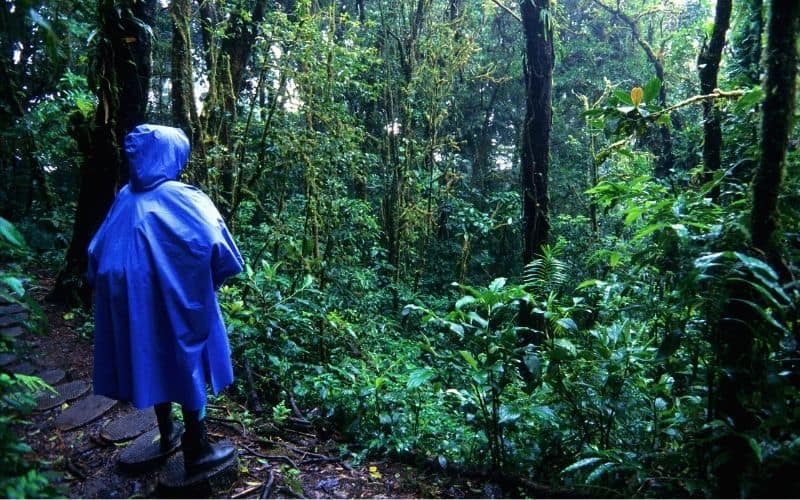
When buying, you’ll also have to decide if you want full-body coverage or not.
Models like the Snugpak Patrol (56.7”), Mil-Tec Waterproof (56.6”), and S2Summit (57”), offer coverage down to just below the knee. The Terra Hiker (36”), however, will only cover most users down to the waist.
Weight and Packed Size
Because your poncho will spend a lot of time in your backpack, only to be deployed when the wet stuff comes, its weight and size are crucial considerations.
The lightest model on our list is the Exped UL, which weighs just 7.1 oz. The CRA Pacific is the heaviest at 17.1 oz. but is a far more durable option.
Also bear in mind that many lightweight ponchos are made with thinner and less rugged materials, or may lack some of the handy features – zippers, pockets, grommets, etc. – found in heavier models.
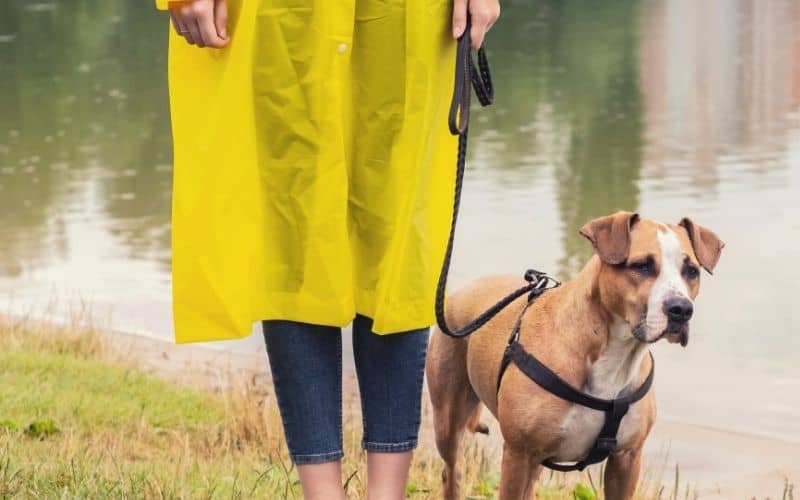
Durability
As with any outdoor product, a rain poncho has to be durable to be value for money.
Of all the fabrics used in the rain ponchos in our review, nylon, PU-coated polyester, and PVC are the most durable, while EVA and polypropylene are the least durable.
Beyond the type of fabric used, the fabric’s density is another key indicator of how durable and resistant to rips and tears it will be. Fabric density is measured in denier (e.g. “15D”) and, generally speaking, the higher the denier count, the tougher the fabric will be.
Versatility
Some rain ponchos are “multi-functional,” meaning they can double as a tarp, ground cover, or even as a shelter. This versatility makes such models especially appealing to gram-counting minimalists who are keen to cut down on pack weight for multi-day adventures.
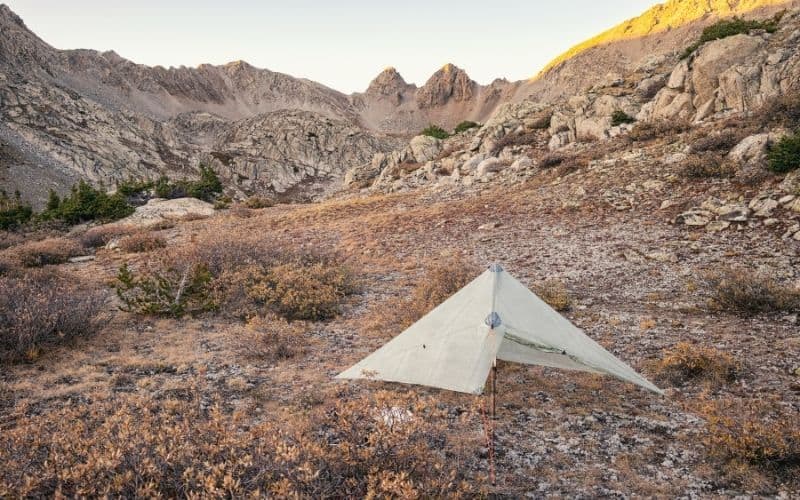
A few of the ponchos on our list are multifunctional. The Terra Hiker can be used as a mat, shelter, or sunshade. The S2S Nano can be used as a pack cover, groundsheet, tarp, or emergency shelter. The Mil-Tec Waterproof can be used as a shelter, groundsheet, or sleeping bag cover. Whilst the Deerhunter can be converted into a tarp or hunting hide.
Extra Features
Compared to hiking jackets, ponchos aren’t blessed with many features. Nevertheless, there are a few add-ons that can help to make one model a more practical choice over another:
- Grommets and Eyelets – Commonly found in multi-functional ponchos, these can be used to peg the poncho out with stakes or ropes to create a tarp shelter.
- Pockets – These are handy for storing your map, compass, and other small essentials. In our review, only the Snugpak Patrol, Vaude, Deerhunter, and Exped Pack UL have a pocket.
- Adjustable Hood – This lets you cinch the hood down on your head, preventing it from being blown back when hiking in strong winds. All of the ponchos on our list have adjustable hoods.
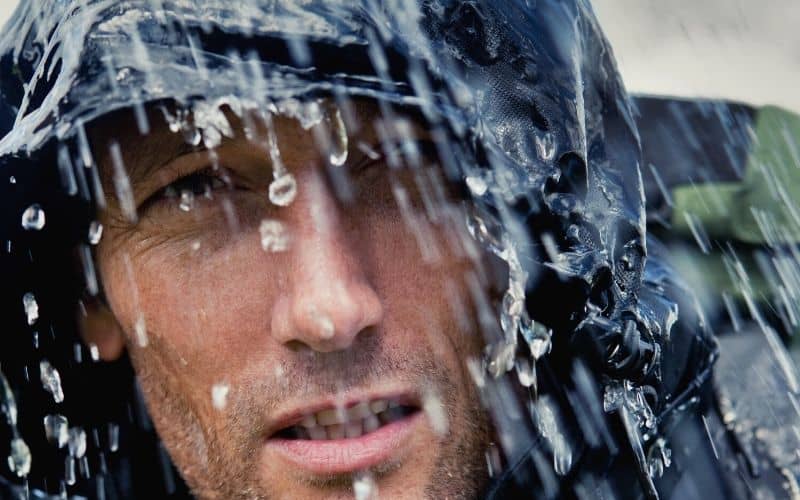
FAQs
How Should I Store My Hiking Poncho?
To prevent it from falling victim to mold and mildew, clean and dry it thoroughly after each use and hang it up in a well-ventilated space.
How Can I Be Sure That a Poncho Will Fit?
Instead of relying on the “one-size-fits-all” or “unisex rain poncho” description in the product listing, make sure you check the dimensions before buying.
If you’re wearing a large backpack, you’ll probably need 50+ inches of width to avoid having an overly snug fit. If you’re not, a wider model (50”-60”) may flap around excessively in the wind and/or leave you feeling like you’re hiking inside a windsock.
The length you need largely depends on your height, but also on whether or not you want full-body coverage.
Some models measure as little as 36” long and will cover the average adult hiker only down to the waist. On the other hand, full-coverage ponchos can measure as much as 60” long. While this is great for taller hikers who want to leave the waterproof pants at home it will only pose a trip hazard for shorter people.
How Do I Know If I Can Use My Rain Poncho as a Shelter?
Because it’s a major selling point, manufacturers will state that their product can be used as a tarp or shelter if this is the case.
How Do I Get The Wrinkles Out of My Poncho?
When not in use, don’t leave it in a stuff sack, storage bag, or folded on a shelf. Instead, air it out and hang it up in a cupboard.
With most rain ponchos, you can also use a steamer on a low heat to release the creases faster.
Best Poncho for Wet Weather: The Verdict
If you’re looking for a durable, waterproof rain poncho that can be transformed into a backpack cover, groundsheet, or even a two-person tent then look no further than the S2S UltraSil Nano.
If you’d prefer a more budget-friendly option you might want to opt for the Terra Hiker. Despite its smaller price tag this poncho still comes with features to make it more usable and is also muti-functional!
For those looking for the toughest there is out there we recommend durable models such as the Deerhunter Survivor, Mil-Tec or the CRA Specific. Both the former are also able to be converted into tarp shelters.
Got any questions or comments? If so, drop us a line in the box below. And please feel free to share this post with your friends!
